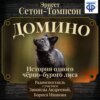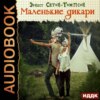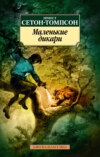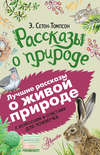Читать книгу: «Bird Portraits», страница 2
THE BARN SWALLOW
There is no pleasanter sight among birds than a family of young reared in the neighborhood of man and often on some part of his house itself. Visit an old farmhouse; look about and see how many welcome guests the farmer shelters without thought of pecuniary profit. Under the woodshed, on a beam, the Phœbe has built a nest of moss, from which she flies to the barnyard to pursue the insects that swarm there. In the vines on the piazza, Robins and Chipping Sparrows have reared their young. In the old elm over the door, an Oriole has woven a nest with thread twitched from the clothesline or perhaps purposely laid out for her, and the orchard shelters numbers of species – Bluebirds, Woodpeckers, Kingbirds, and Chebecs. Of all these tenants, however, none seem so completely at home as the swallows; none show so little concern at man's presence; none take possession so coolly of the boxes, the eaves, or the rafters where they build. Their kindred lived with man, ages ago, in Greece and Rome; they have been welcomed each spring as heralds of a joyful season; their departure has been watched with regret. Though they have but few notes which are musical, yet their grace, agility, and swiftness have passed into proverb and song.
There are several species of swallow, or martin, which take advantage of man's structures in or on which to place their nests, but the most numerous, the most familiar to people in general, and perhaps the most attractive, is the Barn Swallow. This is the only species whose outer tail feathers are long and pointed, and form with the rest of the tail the peculiar figure known as "swallow-tail." The head, back, wings, and tail are all of a beautiful lustrous blue, and the tail, when spread, shows large white spots in the inner feathers. The under parts vary from whitish in immature birds to a rich chestnut in fully mature ones, who have also the throat and forehead of a darker reddish brown. The bill opens far back, so that there is a wide cavity to engulf any insect which may be met in the ceaseless flight backward and forward over grass and water.
The nest of the Barn Swallow is familiar to all who have enjoyed life on a farm. It is made of straws and grass, plastered together with mud, and is placed on a beam or rafter in the barn. One hospitable farmer drove a horseshoe into a beam, and on this ledge a swallow built each year. Through the open door or window of the barn the swallows fly in and out, and up into the gloom above, where twittering sounds tell of young that are being fed. As soon as the young are old enough, the parents urge them to fly, and in a few days they become skillful enough to take food on the wing. This is an extremely pretty spectacle; the parent and the young meet, and then fly upward for an instant, their breasts apparently touching, while the food is passed from one bill to the other. One July afternoon the writer watched a row of six young swallows clinging to the shingles on a barn roof, every mouth gaping for food whenever the parents approached. When the father brought the food, the bird sitting nearest him got the mouthful, and in an instant later another from the mother. Five times in succession this favored youngster was fed, while the other five seemed neglected. But when the little fellow had all that he could hold, he went to sleep, and the next wide-open mouth received the food. What seemed at first an unfair arrangement was after all the surest way to feed all alike.
THE CHIMNEY SWIFT
The Swift is universally known as the Chimney Swallow, from a belief that it belongs to the swallow family. It is, in fact, no relative of the swallows, but very nearly related to the Whippoorwill and Night-hawk. Swifts and swallows both have long, powerful wings, which enable them to remain for long periods on the wing in a restless search for insects. Scientists themselves were for a long time misled by the resemblance in the appearance and habits of the two families, but a close examination of the skeleton of the two birds has convinced naturalists that the two families descended from different ancestors, but have arrived at similar solutions of the problem presented to them in their search for food.
The Swift builds, as is well known, in the flues of chimneys. It is often seen in May, dashing past the dead twigs of some tree, and then off to the chimney, where the twigs are glued together and to the bricks by the help of saliva secreted by the bird. A common and distressing experience after a storm in summer is the discovery of the young Chimney Swifts at the wrong end of the chimney, – on the hearth, in other words. Even in their proper place in the chimney, the young birds can make their presence very well known by beginning, as soon as it is light, an incessant clamor for food.
The long narrow wings, the powerful chest muscles, the cut of the bird's body, and the way the keel is ballasted, so to speak, enable the bird to remain for hours in constant flight without apparently experiencing the least fatigue. Swallows are often seen resting on telegraph wires, but I have never seen a Swift perch on any support outside a chimney. At night and during such part of the day as is given up to rest, the bird supports itself in chimneys by clinging to projections or crevices. The stiff, sharp-pointed tail feathers aid greatly in supporting it. Before the coming of the white man, hollow trees served as the roosting and nesting places of the Swifts.
There is no better practice for the eye than distinguishing swallows from Swifts, when both species are mingled in the air. The Swift's flight, though very powerful, suggests that of the bat, on account of the frequency of the wing strokes; the rapid beating of the wings ceases at intervals and the bird glides through the air or turns on set wings. Then the twinkling flight begins again. There are none of those long sweeping strokes with which the Barn Swallow cleaves the air. The tail of the Swift, when the bird is flying, generally appears short and cigar-shaped, or, if spread, it is fan-shaped, not forked like the tails of all the swallows.
The ordinary note of the Swift is a single sharp cry, slowly or rapidly repeated; it is characteristic of warm summer evenings when the birds fly about the houses in twos or threes, pursuing each other and uttering this note staccato. A pretty sight at this time is the Swift sailing with wings raised above the body, in the position of our common pigeon just before alighting; the Swift assumes the same attitude above the chimney, poising a moment before he drops into the flue.
Early in September the Swifts leave the North, and may be seen high overhead flying southward; unlike many of our small birds, they migrate by day, their powers of flight protecting them from the birds of prey which are such a menace to the smaller birds.
THE KINGBIRD
The swallows and swifts spend hours on the wing, turning to the right or to the left, upward or back, in pursuit of winged insects. Many other birds, notably the warbler family, take occasional flights after some insect which they have startled from the leaves. The habits of another large family of birds, the Flycatchers, are a compromise between these two methods of obtaining food. Selecting some post of observation, such as a dead limb, a fence, or the stalk of a stout weed, they wait patiently, keeping a sharp watch of the air about them. At sight of an insect flying near, they fly out in pursuit. If one is near enough to the bird, a click of its bill will announce the fate of the insect. The Flycatchers then return to the same or a neighboring perch.
The family is not, on the whole, very good-humored; in fact, they might justly be accused of irritability and pugnacity. The Kingbird, in particular, the head of the house, is noted for his constant attacks on any winged creature that approaches his nest. It must be admitted, however, that when nesting time is over, he lives very peaceably with his neighbors; but while the female is brooding the eggs or young, the excited cry of the male is constantly heard, and every Crow that comes in sight is pursued, sometimes for a mile. The Kingbird gets above his victim and darts down at its head; the Crow can be seen wincing at each vicious jab of the bill. One or two observers have actually seen the Kingbird ride on the Crow's back for some distance. The Kingbird has a patch of red concealed under the black feathers of his crown; when he is angry or excited, these red feathers blaze out. They are very rarely seen by men, but I imagine the Crows see them oftener than they like.
Apple trees in old orchards are favorite nesting places of the Kingbird, and no pains are taken to conceal the nest. It is composed of twigs loosely laid together, and often festooned with white strings or the dry, woolly heads of the mouse-ear everlasting. The inside of the nest is neatly lined with feathers, horsehair, or roots, and contains from three to five white eggs spotted with brown. The Kingbird is here from the first of May to the first of September, but like all strictly insectivorous birds, it must spend the winter far to the southward. The bird's only notes are the shrill cries, kipper, kipper, given singly or quickly repeated. In spring the birds often mount to a considerable height, uttering this cry continually, and apparently attempting, by this exhibition, to express the emotion common to all creatures at this period of the year.
The Kingbird is a very satisfactory bird to beginners; the color pattern is so marked and the bird is so fond of exposed situations that it is seen and recognized without difficulty. Except the Cedarbird, whose tail is tipped with yellow, I know no other small bird of the eastern United States whose tail feathers are all tipped with a regular edge of light color. The Kingbird is the bird most commonly seen from a car window; in almost every field, the mullein stalks or wire fences will display one or more individuals, their white breasts or black and white tails showing conspicuously in the landscape.
The Kingbird has often been accused of destroying honeybees. Even allowing that individuals occasionally do some damage in this way, the good services of the race in destroying harmful insects far outweigh these injuries, and the remedy is to drive the bird away from the hives, not to kill it.





















